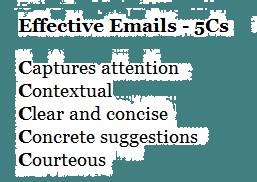 Email is one of the primary methods of communicating at work today. “What so hard about writing an effective email?” you may ask. Well, the mechanics of sending an email are simple, but if you want to facilitate effective email communication (e.g. your email is read, understood ,and acted upon in the time frame you desire), then there are certain skills involved in writing a good email.
Email is one of the primary methods of communicating at work today. “What so hard about writing an effective email?” you may ask. Well, the mechanics of sending an email are simple, but if you want to facilitate effective email communication (e.g. your email is read, understood ,and acted upon in the time frame you desire), then there are certain skills involved in writing a good email.
Effective email communication helps you get work done faster. On the other hand, an in-effective email, one that is vague or lacks context, can create more work for you and others. I created the following principles to help you communicate effectively through email.
- Capture Attention – write targeted subject lines, and get to the point early. With so many emails in someone’s inbox, how you write the subject line matters. Most people can see the first 6 words in the preview pane, so make sure you write a subject line that can give the reader a quick idea of what the email is about. Sometimes, lead words like “Response needed…Help pls…FYI…Vote” can help. Once the reader opens the email, he or she should be able to quickly understand what you want. Also, make sure that you summarize what you want from your reader early in the email, and bold it.
- Contextualize – always provide context, don’t assume the reader knows or remembers it. People are busy thinking about their own work. Don’t ever assume that the reader knows the context of your email, even if you just spoke to her about it an hour ago. When someone opens an email, she may still be thinking about some other thing she is working on. So, summarize the context behind this email, and the background information she needs in order to give you a response. Attach documents if necessary. The better you are at doing this, the less work it is for the reader to respond to you.
- Clear and Concise – provide information that can be clearly understood by others, and keep it short. I think we all intend to be clear, but it is not always received that way. Sometimes it helps to step away from a draft, or get someone else to read it to make sure it’s clear before sending. Of course, this would only apply to important emails, as you won’t have time to do it for all email communications. Also, keep it short, use bullets, and only include information that is needed. People can be daunted by a long email. Even if you think your request is easy, if someone sees a long email they may skip it and plan to read it later, because they assume that it will take time to respond. Additionally, the more senior the person, the more concise you have to be, as they never get through all their emails. Lastly, sometimes it makes sense to write two separate emails if you have two different items to discuss with the same person.
- Concrete Suggestions – avoid open ended questions. Instead, offer potential response options. One of the goals of effective email communication is to make it easy for the reader to respond. The more senior the recipient, the more you should do this. People don’t need to think as much if you give them 3 options to choose from, versus an open-ended question. For example, instead of saying “can you suggest a time frame for when we can meet up with client X,” you can say, “It would be great if we could meet up with Client X in the next two weeks. Would any of the following times work for you?” Put down 3 choices. Even if all three options don’t work, the recipient is more likely to offer an alternative in response.
- Courtesy – make it personal. Lastly, it’s always important to start and end an email with some courteous words. It will make the email more personal, and again increase the likelihood of response. At the beginning, address the person by their first name (in the US, first name is usually OK). You can then start wit ha bit of small talk, like “it was great to see you today…hope your week is going well.” End your email with some greeting like, “best regards…thank you for your time,” and then sign your name.
These are my high level suggestions. I created a Business Email Etiquette Checklist to help with your next important email. Go to the link and print out the checklist. You can use it next time to easily review your email draft, and identify ways to make it the most effective.
Your comments: Share your experience — is there anything else you do to make your emails more effective? Add your comments below and let’s have a discussion.
Like this article? Then help me out and share it on Linkedin, Email, Twitter, Facebook, Google+, etc.
– Lei
Is it appropriate not to use a greeting and/or closing when you are involved in an email exchange and both parties are clear about what is being discussed?
Valerie, good point. this is more for initial emails and not as needed for an ongoing exchange that is happening within a short period of time. Thanks for the question.
What would be considered a lengthy email?
How important is a proper salutation, and what does one look like?